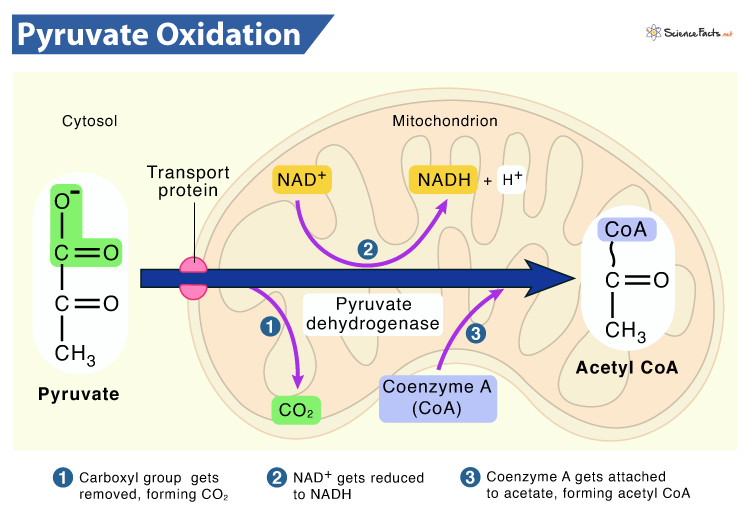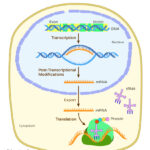At the end of glycolysis, a single glucose molecule splits into two pyruvates (C3H4O3). Due to this, the link reaction occurs twice for each glucose molecule yielding a total of 2 acetyl-CoA molecules. This acetyl CoA then enters the Krebs cycle or citric acid cycle and fuels the reactions.
Location: Where does Pyruvate Oxidation Occur
Steps of Pyruvate Oxidation
Chemical Equation
In prokaryotes, it occurs in the cytoplasm. This conversion takes place in three steps: Step 1: Initially, the enzyme pyruvate dehydrogenase removes the carboxyl group from the 3-carbon molecule, pyruvate, releasing carbon dioxide. As a result, a two-carbon hydroxyethyl group bound to the enzyme is left behind. Step 2: In the next step, the two-carbon molecule from the previous step gets oxidized. NAD+ picks up the electrons lost in the oxidation to form NADH. Thus, NAD+ gets reduced to NADH, forming acetate. Step 3: Finally, coenzyme A, a sulfur-containing compound derived from vitamin B5, gets attached to the acetate via its sulfur atom, yielding acetyl coenzyme A, or acetyl CoA. This acetyl CoA acts as a carrier molecule, carrying the acetyl group to the citric acid cycle. 2 Pyruvate + 2 NAD+ + 2 CoA → 2 Acetyl-CoA + 2 NADH + 2 CO2 + 2 H+ Simplified as, Pyruvate + NAD+ + CoA → Acetyl-CoA + NADH + CO2 + H+ Reactants
- Pyruvate
- NAD+ – Nicotinamide adenine dinucleotide (oxidized)
- CoA – Coenzyme A Products
- Acetyl-CoA – Acetyl coenzyme A
- NADH – Nicotinamide adenine dinucleotide (reduced)
- CO2 – Carbon dioxide
- H+ – Hydrogen ion or proton Comment * Name * Email * Website Save my name, email, and website in this browser for the next time I comment.
Δ




